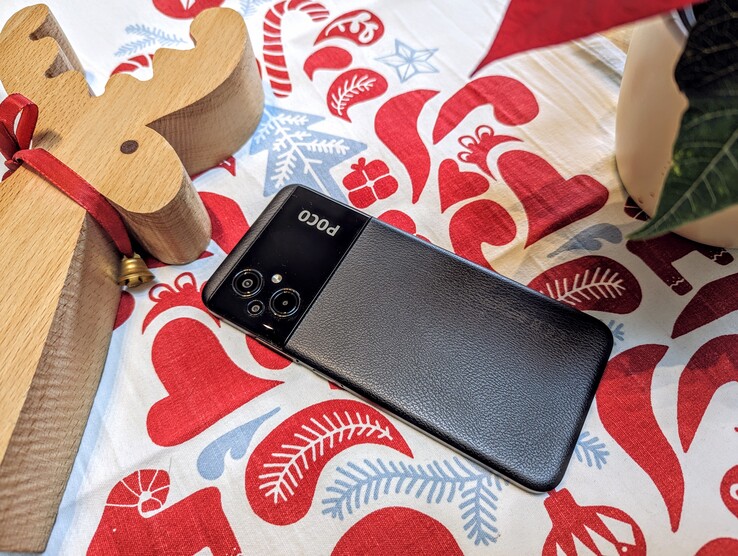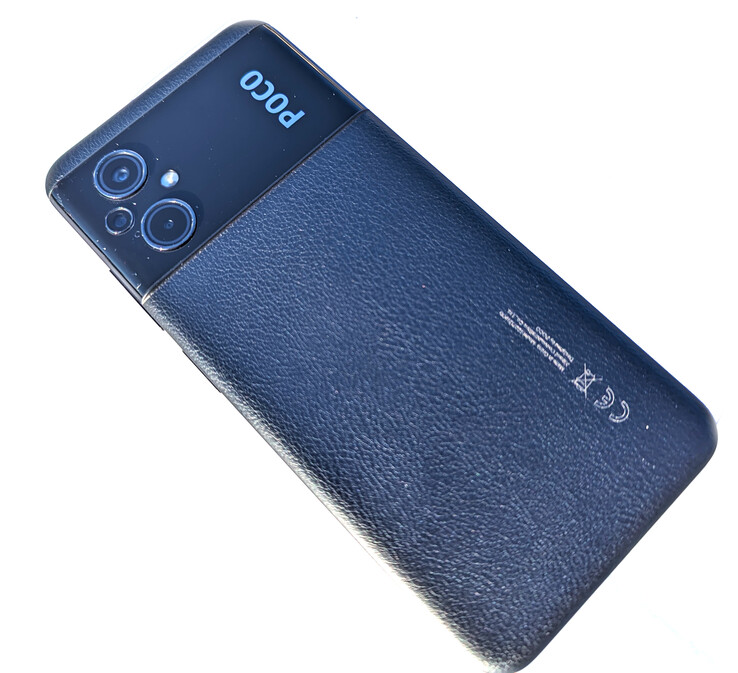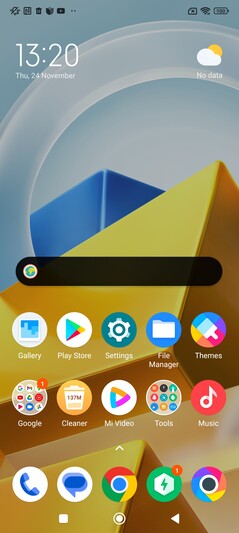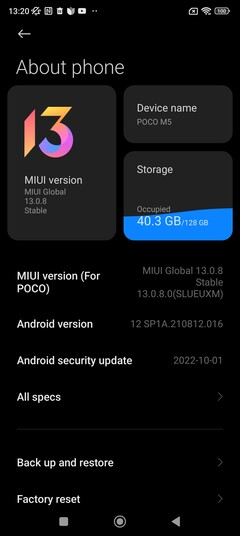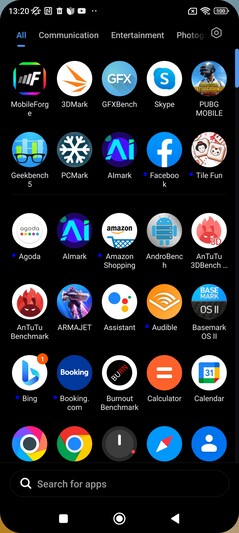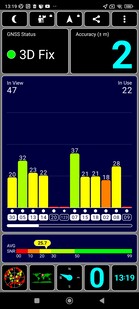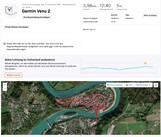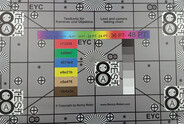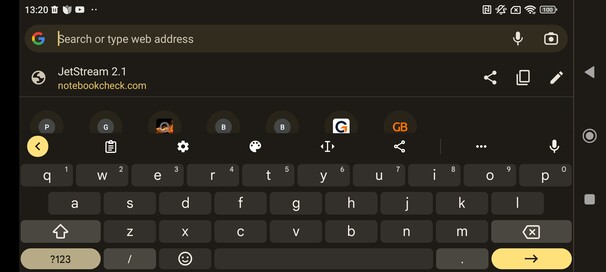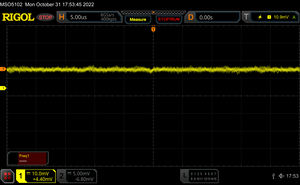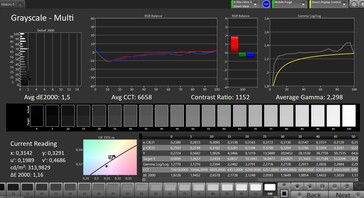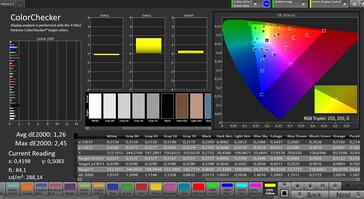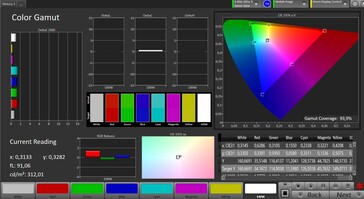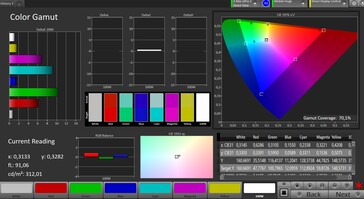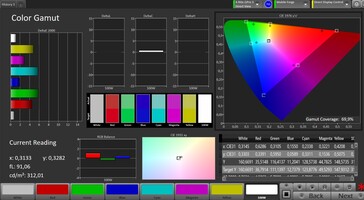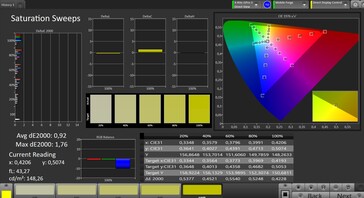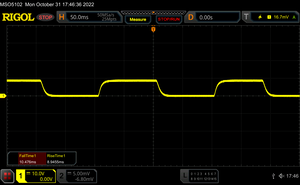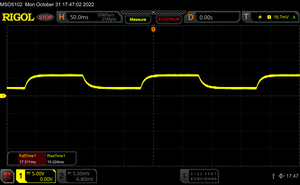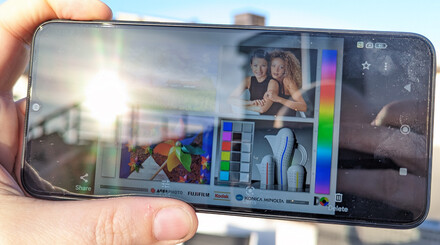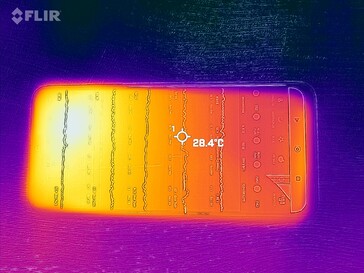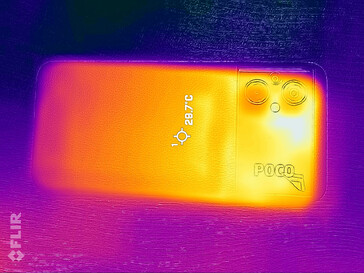Xiaomi Poco M5 Smartphone review – Affordable phone that packs a lot of power
There are quite a number of budget Xiaomi phones on the market, and most of them offer great specs for their price. The Poco M5 costs around 200 Euro (US$210) and features a fairly fast processor, a Full HD display with a 90Hz refresh rate, and a large battery.
That said, even Xiaomi can't do wonders and is unable to offer consumers a phone with 5G capability at this low price point. In this review, we'll take a closer look at whether the phone continues Xiaomi's tradition of offering great value for money.
Comparison with possible competitors
Rating | Date | Model | Weight | Drive | Size | Resolution | Price |
|---|---|---|---|---|---|---|---|
| 78.9 % v7 (old) | 11 / 2022 | Xiaomi Poco M5 Helio G99, Mali-G57 MP2 | 201 g | 128 GB UFS 2.2 Flash | 6.58" | 2408x1080 | |
| 77.3 % v7 (old) | 11 / 2022 | Samsung Galaxy A13 4G A137F Helio G80, Mali-G52 MP2 | 195 g | 64 GB eMMC Flash | 6.60" | 2408x1080 | |
| 74.4 % v7 (old) | 11 / 2022 | Xiaomi Poco C40 JR510, Mali-G52 MP1 | 204 g | 32 GB eMMC Flash | 6.71" | 1650x720 | |
| 76 % v7 (old) | 08 / 2022 | Realme Narzo 50A Prime T7225 (T612), Mali-G52 MP1 | 192.5 g | 64 GB UFS 2.2 Flash | 6.60" | 2408x1080 | |
| 75.1 % v7 (old) | 05 / 2022 | Motorola Moto G22 Helio G37, PowerVR GE8320 | 185 g | 64 GB eMMC Flash | 6.50" | 1600x720 |
Case – Fingerprint-resistant leatherette
We like the leatherette design on the phone's body. It is resistant to fingerprints and feels comfortable to the touch. The camera module extends across the entire width of the chassis, meaning the phone doesn't wobble when it is placed flat on a table.
Xiaomi is bold when it comes to colour selection. In addition to a more understated green and black (as you might expect), the Poco M5 is available in yellow as well. The phone has great fit and finish and feels very sturdy for its price. Xiaomi claims that the display is protected by Gorilla Glass but doesn't specify which version is used on the phone.
Specifications – NFC included
In Central Europe, all models of the Poco M5 come with 4 GB of RAM (a version with 6 GB of RAM is also available in other markets). The phone starts at 189.99 Euro (US$167) for 64 GB of storage and costs 20 Euro (US$21) more for 128 GB of storage.
Like many budget phones, the Xiaomi Poco M5 still has a headphone jack. Charging is done through the USB-C port, which only supports the very sluggish USB 2.0 speeds for data transfer. One unique feature of the phone is its IR blaster, which you can use to control devices such as a television.
There is also NFC on board – which isn't always a given for phones under 200 Euro (US$210). This means you can use mobile payment services (e.g. Google Pay) on the Poco M5.
microSD card reader
The smartphone can accommodate two Nano SIM cards at the same time. There is also a separate microSD card slot for storage expansion. The card reader was quite fast and reliable when we tested it with our reference microSD card (Angelbird V60).
| SD Card Reader - average JPG Copy Test (av. of 3 runs) | |
| Samsung Galaxy A13 4G A137F (Angelbird V60) | |
| Xiaomi Poco M5 (Angelbird V60) | |
| Motorola Moto G22 (Angelbird V60) | |
| Realme Narzo 50A Prime (Angelbird V60) | |
| Xiaomi Poco C40 (Angelbird V60) | |
Cross Platform Disk Test (CPDT)
Software – Only Android 12 for now
MIUI 13 is based on Android 12. The security patches on the phone were dated October 2022 and were thus still very up to date at the time of this review. Unlike the Xiaomi Poco M5s, the Poco M5 isn't on the list of Xiaomi devices that are certfied for Google's AER programme and for which the update support period has been specified. Based on our experience with previous Xiaomi devices, though, we would expect at least one OS update as well as security updates until 2024.
Many apps have been preinstalled on the phone right out of the box, some of which are third-party apps that Xiaomi gets paid to install on the device (including games). If you like your system clean, you'll need to manually remove any unwanted apps first.
Connectivity and GNSS – No 5G support for the Poco M5
As previously mentioned, you won't get any 5G connectivity with the Xiaomi Poco M5. Most 5G phones are considerably more expensive than 200 Euro (US$210).
If you wish to travel with a Poco M5, we recommend that you check whether the device is compatible with the cellular data network in the destination country. This affordable device is not a phone for travelling the world.
During our test with the reference router Asus ROG Rapture AXE11000, the Wi-Fi 5 chip in the Poco M5 delivered great results and outperformed the wireless solutions in most smartphones in this price range. Internet access is quick and stable over Wi-Fi.
Outdoors, the phone's location tracking is accurate to roughly 2 metres (6.6 feet). The Poco M5 is able to communicate reliably with major global satellite networks and even uses SBAS to further enhance accuracy.
Nevertheless, a theory remains a theory. For our real-life test, we hopped on our bike and took it for a ride. During this test, the Xiaomi Poco M5 definitely exhibited some issues with location tracking accuracy: the phone indicated that we mostly cycled through houses and front gardens rather than on the road. Corners and turns were often cut short, and most of the time, we are unable to correctly tell which side of the street we were riding on.
So if you rely a lot on your smartphone for navigation, there are much more accurate options available, even in this price range.
Call functions and voice quality – Speech could use more fullness
The Xiaomi Poco M5 uses Google's phone calling app, which works well and has a very clean design. Other calling apps can also be installed on the phone, but you should exercise caution and choose one from a reputable developer.
During our test call, the person on the other end sounded quite far away and not very full through the built-in ear speaker. Our voice, however, was clear and understandable and didn't have any background noises. When we were using the hands-free microphone and built-in speaker, the other person sounded clearer on our end, but their voice was accompanied by some minor noises. In hands-free mode, the phone picked up our voice clearly, even when we spoke softly.
Cameras – Standard fare in the budget segment
The main camera on the back has a 50MP Samsung sensor and is only flanked by a 2MP macro camera and a depth camera. The camera setup is similar to what you'll find on many other budget phones. For instance, the realme Narzo 50A Prime has almost the same camera specs as the Poco M5.
Images produced by the main camera look quite dark, could do better in terms of sharpness and are not very detailed upon closer examination. In low-light conditions, dark areas simply appear black, and images turn out very grainy. The setup is adequate for snapshots, but there are much better phone cameras out there.
The phone lets users record 1080p videos at up 30 fps. The exposure correction does its job well, but the autofocus could be slightly faster. You also shouldn't expect vibrant colours from the camera.
Xiaomi has installed a front camera with a measly 5MP resolution. Selfies taken with the camera may look quite good at first glance, but darker areas are lacking in sharpness and details on closer inspection.
Image comparison
Choose a scene and navigate within the first image. One click changes the position on touchscreens. One click on the zoomed-in image opens the original in a new window. The first image shows the scaled photograph of the test device.
Hauptkamera BlumeHauptkamera UmgebungHauptkamera Low LightWe also put the main camera through its paces in our lab. Under optimal lighting, the camera produced photos that are dull but have good contrast. There is also a considerable decrease in sharpness towards the edges. At a light intensity of just 1 lux, brighter colours are still perceptible, but the image ends up being very grainy.
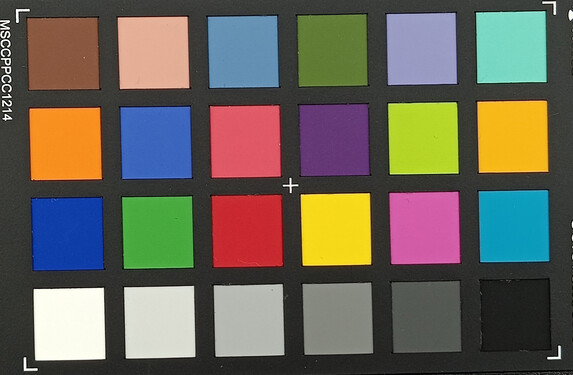

Accessories and warranty – Charger included
The Poco M5 comes with a fairly substantial range of accessories: a charger, USB-C cable, SIM ejector tool and silicone protective case are all included in the box, meaning you won't have to buy anything else right away for everyday use.
Xiaomi provide a 24-month warranty on the Poco M5 in the EU. However, warranty terms and conditions may vary by country. You can refer to Poco's warranty page for more information.
Input devices and operation – Speedy fingerprint sensor
The touchscreen is pleasant to use and highly reliable. It also run very smoothly thanks to its 90Hz refresh rate and 240Hz touch sampling rate.
The fingerprint sensor is integrated into the power button on the right side of the chassis. It is able to recognise fingers very reliably and unlocks the phone more or less instantly.
You can also use your face to unlock the phone. Whilst this method works just as well, it is slightly less secure.
Display – High-resolution, but not quite bright
Even today, you still won't find a Full HD display on every phone under 200 Euro (US$210). The Poco M5 does well in this department and features a 1080p screen.
Unfortunately, the same can't be said about the display's brightness: the screen didn't get any brighter than 402 cd/m² even when the ambient light sensor was exposed to intense light. This peak brightness is significantly lower than what the competitors are capable of.
That said, brightness distribution is very even. And the display manages to deliver a reasonable level of contrast due to its low black level.
| |||||||||||||||||||||||||
Brightness Distribution: 96 %
Center on Battery: 400 cd/m²
Contrast: 1481:1 (Black: 0.27 cd/m²)
ΔE ColorChecker Calman: 1.26 | ∀{0.5-29.43 Ø4.78}
ΔE Greyscale Calman: 1.5 | ∀{0.09-98 Ø5}
93.9% sRGB (Calman 2D)
Gamma: 2.298
CCT: 6658 K
| Xiaomi Poco M5 IPS, 2408x1080, 6.6" | Samsung Galaxy A13 4G A137F PLS, 2408x1080, 6.6" | Xiaomi Poco C40 IPS, 1650x720, 6.7" | Realme Narzo 50A Prime IPS, 2408x1080, 6.6" | Motorola Moto G22 IPS LCD, 1600x720, 6.5" | |
|---|---|---|---|---|---|
| Screen | -77% | -113% | -77% | -123% | |
| Brightness middle (cd/m²) | 400 | 492 23% | 468 17% | 540 35% | 451 13% |
| Brightness (cd/m²) | 396 | 453 14% | 450 14% | 523 32% | 431 9% |
| Brightness Distribution (%) | 96 | 87 -9% | 92 -4% | 93 -3% | 90 -6% |
| Black Level * (cd/m²) | 0.27 | 0.37 -37% | 0.4 -48% | 0.39 -44% | 0.5 -85% |
| Contrast (:1) | 1481 | 1330 -10% | 1170 -21% | 1385 -6% | 902 -39% |
| Colorchecker dE 2000 * | 1.26 | 4.34 -244% | 4.53 -260% | 4.39 -248% | 5.82 -362% |
| Colorchecker dE 2000 max. * | 2.45 | 5.94 -142% | 8.96 -266% | 6.65 -171% | 9.3 -280% |
| Greyscale dE 2000 * | 1.5 | 4.7 -213% | 6.5 -333% | 4.7 -213% | 5 -233% |
| Gamma | 2.298 96% | 2.398 92% | 2.191 100% | 2.261 97% | 2.776 79% |
| CCT | 6658 98% | 7668 85% | 8122 80% | 7597 86% | 7683 85% |
* ... smaller is better
Screen Flickering / PWM (Pulse-Width Modulation)
| Screen flickering / PWM not detected | |||
In comparison: 53 % of all tested devices do not use PWM to dim the display. If PWM was detected, an average of 8118 (minimum: 5 - maximum: 343500) Hz was measured. | |||
In terms of colour reproduction, none of the other phones in this price range measure up to the Xiaomi Poco M5. The phone's display reproduces colours very faithfully and doesn't exhibit any blue tint when showing shades of grey.
Display Response Times
| ↔ Response Time Black to White | ||
|---|---|---|
| 20 ms ... rise ↗ and fall ↘ combined | ↗ 11 ms rise | |
| ↘ 9 ms fall | ||
| The screen shows good response rates in our tests, but may be too slow for competitive gamers. In comparison, all tested devices range from 0.1 (minimum) to 240 (maximum) ms. » 42 % of all devices are better. This means that the measured response time is similar to the average of all tested devices (20.2 ms). | ||
| ↔ Response Time 50% Grey to 80% Grey | ||
| 33 ms ... rise ↗ and fall ↘ combined | ↗ 18 ms rise | |
| ↘ 15 ms fall | ||
| The screen shows slow response rates in our tests and will be unsatisfactory for gamers. In comparison, all tested devices range from 0.165 (minimum) to 636 (maximum) ms. » 43 % of all devices are better. This means that the measured response time is similar to the average of all tested devices (31.6 ms). | ||
The highly reflective display makes the phone difficult to use outdoors in direct sunlight, though you can still partially make out what is on the screen.
The perceived screen brightness only changes slightly with your viewing angle. Otherwise, contents on the screen are easily readable regardless of where you are viewing it from.
Performance – Packs a lot of punch
The Poco M5 features an SoC that delivers a lot performance for this price point. The MediaTek Helio G99 has a total of eight cores distributed across two clusters with clockspeeds of up to 2.2 GHz. As a result, the Poco M5 sometimes scored two or even three times higher than other phones under 200 Euro (US$210) in Geekbench's CPU benchmark.
In day-to-day use, this means that you can navigate menus without any stutters for the most part and that the phone has enough performance to handle slightly more demanding apps.
| Antutu v9 - Total Score | |
| Average of class Smartphone (99654 - 2056989, n=29, last 2 years) | |
| Xiaomi Poco M5 | |
| Average Mediatek Helio G99 (229468 - 375956, n=8) | |
| Xiaomi Poco C40 | |
| Motorola Moto G22 | |
| CrossMark - Overall | |
| Average of class Smartphone (187 - 2674, n=126, last 2 years) | |
| Xiaomi Poco M5 | |
| Average Mediatek Helio G99 (526 - 602, n=13) | |
| Xiaomi Poco C40 | |
| Motorola Moto G22 | |
| UL Procyon AI Inference for Android - Overall Score NNAPI | |
| Average of class Smartphone (3769 - 81594, n=137, last 2 years) | |
| Xiaomi Poco M5 | |
| Average Mediatek Helio G99 (6323 - 9695, n=13) | |
| Motorola Moto G22 | |
| Xiaomi Poco C40 | |
| AImark - Score v3.x | |
| Average of class Smartphone (82 - 307528, n=126, last 2 years) | |
| Average Mediatek Helio G99 (842 - 1001, n=10) | |
| Xiaomi Poco M5 | |
The Poco M5 also outclasses other similarly priced phones when it comes to graphics performance.
Nonetheless, the phone only hit 60 fps during very basic graphics benchmarks and quickly fell below the 30 fps mark. You probably shouldn't expect the phone to run graphically demanding applications well.
GFXBench (DX / GLBenchmark) 2.7: T-Rex Onscreen | 1920x1080 T-Rex Offscreen
GFXBench 3.0: on screen Manhattan Onscreen OGL | 1920x1080 1080p Manhattan Offscreen
GFXBench 3.1: on screen Manhattan ES 3.1 Onscreen | 1920x1080 Manhattan ES 3.1 Offscreen
GFXBench: on screen Car Chase Onscreen | 1920x1080 Car Chase Offscreen | on screen Aztec Ruins High Tier Onscreen | 2560x1440 Aztec Ruins High Tier Offscreen | on screen Aztec Ruins Normal Tier Onscreen | 1920x1080 Aztec Ruins Normal Tier Offscreen
| 3DMark / Wild Life Extreme Unlimited | |
| Xiaomi Poco M5 | |
| Samsung Galaxy A13 4G A137F | |
| Realme Narzo 50A Prime | |
| 3DMark / Wild Life Extreme | |
| Xiaomi Poco M5 | |
| Samsung Galaxy A13 4G A137F | |
| Realme Narzo 50A Prime | |
| 3DMark / Wild Life Unlimited Score | |
| Xiaomi Poco M5 | |
| Samsung Galaxy A13 4G A137F | |
| Realme Narzo 50A Prime | |
| 3DMark / Wild Life Score | |
| Xiaomi Poco M5 | |
| Samsung Galaxy A13 4G A137F | |
| Realme Narzo 50A Prime | |
| Motorola Moto G22 | |
| 3DMark / Sling Shot Extreme (Vulkan) Unlimited Physics | |
| Xiaomi Poco M5 | |
| Realme Narzo 50A Prime | |
| Samsung Galaxy A13 4G A137F | |
| Motorola Moto G22 | |
| 3DMark / Sling Shot Extreme (Vulkan) Unlimited Graphics | |
| Xiaomi Poco M5 | |
| Samsung Galaxy A13 4G A137F | |
| Realme Narzo 50A Prime | |
| Motorola Moto G22 | |
| 3DMark / Sling Shot Extreme (Vulkan) Unlimited | |
| Xiaomi Poco M5 | |
| Samsung Galaxy A13 4G A137F | |
| Realme Narzo 50A Prime | |
| Motorola Moto G22 | |
| 3DMark / Sling Shot Extreme (ES 3.1) Unlimited Physics | |
| Xiaomi Poco M5 | |
| Realme Narzo 50A Prime | |
| Samsung Galaxy A13 4G A137F | |
| Xiaomi Poco C40 | |
| Motorola Moto G22 | |
| 3DMark / Sling Shot Extreme (ES 3.1) Unlimited Graphics | |
| Xiaomi Poco M5 | |
| Samsung Galaxy A13 4G A137F | |
| Realme Narzo 50A Prime | |
| Xiaomi Poco C40 | |
| Motorola Moto G22 | |
| 3DMark / Sling Shot Extreme (ES 3.1) Unlimited | |
| Xiaomi Poco M5 | |
| Samsung Galaxy A13 4G A137F | |
| Realme Narzo 50A Prime | |
| Xiaomi Poco C40 | |
| Motorola Moto G22 | |
| 3DMark / Sling Shot Extreme (ES 3.1) | |
| Xiaomi Poco M5 | |
| Samsung Galaxy A13 4G A137F | |
| Realme Narzo 50A Prime | |
| Xiaomi Poco C40 | |
| Motorola Moto G22 | |
| 3DMark / Sling Shot Extreme (ES 3.1) Graphics | |
| Xiaomi Poco M5 | |
| Samsung Galaxy A13 4G A137F | |
| Realme Narzo 50A Prime | |
| Xiaomi Poco C40 | |
| Motorola Moto G22 | |
| 3DMark / Sling Shot Extreme (ES 3.1) Physics | |
| Xiaomi Poco M5 | |
| Realme Narzo 50A Prime | |
| Samsung Galaxy A13 4G A137F | |
| Xiaomi Poco C40 | |
| Motorola Moto G22 | |
| GFXBench (DX / GLBenchmark) 2.7 / T-Rex Onscreen | |
| Xiaomi Poco M5 | |
| Motorola Moto G22 | |
| Xiaomi Poco C40 | |
| GFXBench (DX / GLBenchmark) 2.7 / T-Rex Offscreen | |
| Xiaomi Poco M5 | |
| Motorola Moto G22 | |
| Xiaomi Poco C40 | |
| GFXBench 3.0 / Manhattan Onscreen OGL | |
| Xiaomi Poco M5 | |
| Motorola Moto G22 | |
| Xiaomi Poco C40 | |
| GFXBench 3.0 / 1080p Manhattan Offscreen | |
| Xiaomi Poco M5 | |
| Motorola Moto G22 | |
| Xiaomi Poco C40 | |
| GFXBench 3.1 / Manhattan ES 3.1 Onscreen | |
| Xiaomi Poco M5 | |
| Xiaomi Poco C40 | |
| Motorola Moto G22 | |
| GFXBench 3.1 / Manhattan ES 3.1 Offscreen | |
| Xiaomi Poco M5 | |
| Motorola Moto G22 | |
| Xiaomi Poco C40 | |
| GFXBench / Car Chase Onscreen | |
| Xiaomi Poco M5 | |
| Xiaomi Poco C40 | |
| Motorola Moto G22 | |
| GFXBench / Car Chase Offscreen | |
| Xiaomi Poco M5 | |
| Xiaomi Poco C40 | |
| Motorola Moto G22 | |
| GFXBench / Aztec Ruins High Tier Onscreen | |
| Xiaomi Poco M5 | |
| Samsung Galaxy A13 4G A137F | |
| Motorola Moto G22 | |
| Xiaomi Poco C40 | |
| Realme Narzo 50A Prime | |
| GFXBench / Aztec Ruins High Tier Offscreen | |
| Xiaomi Poco M5 | |
| Samsung Galaxy A13 4G A137F | |
| Realme Narzo 50A Prime | |
| Motorola Moto G22 | |
| Xiaomi Poco C40 | |
| GFXBench / Aztec Ruins Normal Tier Onscreen | |
| Xiaomi Poco M5 | |
| Samsung Galaxy A13 4G A137F | |
| Motorola Moto G22 | |
| Xiaomi Poco C40 | |
| Realme Narzo 50A Prime | |
| GFXBench / Aztec Ruins Normal Tier Offscreen | |
| Xiaomi Poco M5 | |
| Samsung Galaxy A13 4G A137F | |
| Realme Narzo 50A Prime | |
| Motorola Moto G22 | |
| Xiaomi Poco C40 | |
For web browsing, the Poco M5 is likewise much snappier than other similarly priced phones.
Websites are rendered promptly on the phone, and images are often already available while the user is still scrolling. Even complex HTML5 pages load quickly on the M5 most of the time.
| Jetstream 2 - 2.0 Total Score | |
| Average of class Smartphone (23.8 - 387, n=153, last 2 years) | |
| Average Mediatek Helio G99 (46.9 - 90.3, n=13) | |
| Xiaomi Poco M5 (Chrome 107) | |
| Motorola Moto G22 (Chrome101) | |
| Speedometer 2.0 - Result 2.0 | |
| Average of class Smartphone (15.2 - 643, n=128, last 2 years) | |
| Average Mediatek Helio G99 (24.1 - 90.1, n=12) | |
| Xiaomi Poco M5 (Chome 107) | |
| Motorola Moto G22 (Chrome101) | |
| Xiaomi Poco C40 (Chome 106) | |
| WebXPRT 4 - Overall | |
| Average of class Smartphone (27 - 306, n=147, last 2 years) | |
| Average Mediatek Helio G99 (39 - 89, n=13) | |
| Xiaomi Poco M5 (Chrome 107) | |
| Xiaomi Poco C40 (Chrome 106) | |
| WebXPRT 3 - Overall | |
| Average of class Smartphone (38 - 380, n=35, last 2 years) | |
| Average Mediatek Helio G99 (80 - 112, n=8) | |
| Xiaomi Poco M5 (Chrome 107) | |
| Xiaomi Poco C40 (Chrome 106) | |
| Motorola Moto G22 (Chrome101) | |
| Octane V2 - Total Score | |
| Average of class Smartphone (2228 - 121337, n=200, last 2 years) | |
| Average Mediatek Helio G99 (17228 - 26476, n=24) | |
| Xiaomi Poco M5 (Chrome 107) | |
| Samsung Galaxy A13 4G A137F (Chrome 107) | |
| Xiaomi Poco C40 (Chrome 106) | |
| Motorola Moto G22 (Chrome101) | |
| Mozilla Kraken 1.1 - Total | |
| Motorola Moto G22 (Chrome101) | |
| Xiaomi Poco C40 (Chrome 106) | |
| Xiaomi Poco M5 (Chrome 107) | |
| Average Mediatek Helio G99 (1600 - 2444, n=13) | |
| Average of class Smartphone (257 - 28190, n=155, last 2 years) | |
* ... smaller is better
The UFS 2.2 storage in the Poco M5 has impressively high read/write speeds, particularly in this price range. Of all the devices in our comparison, only the realme Narzo 50A Prime comes close to keeping up with the M5.
| Xiaomi Poco M5 | Samsung Galaxy A13 4G A137F | Xiaomi Poco C40 | Realme Narzo 50A Prime | Motorola Moto G22 | Average 128 GB UFS 2.2 Flash | Average of class Smartphone | |
|---|---|---|---|---|---|---|---|
| AndroBench 3-5 | -70% | -80% | -35% | -86% | -29% | 72% | |
| Sequential Read 256KB (MB/s) | 976.4 | 300.6 -69% | 281.7 -71% | 852.8 -13% | 215.45 -78% | 736 ? -25% | 2223 ? 128% |
| Sequential Write 256KB (MB/s) | 870.7 | 230.3 -74% | 129.8 -85% | 266 -69% | 112.78 -87% | 532 ? -39% | 1838 ? 111% |
| Random Read 4KB (MB/s) | 247.6 | 94.5 -62% | 29.2 -88% | 145.3 -41% | 39.32 -84% | 193 ? -22% | 295 ? 19% |
| Random Write 4KB (MB/s) | 257.8 | 61.5 -76% | 67.7 -74% | 212.5 -18% | 16.34 -94% | 186.3 ? -28% | 335 ? 30% |
Gaming – Rarely above 30 fps
Despite offering great value for money, the Poco M5 isn't a true gaming phone. This is underscored by the games we tested on the device. The fast-paced shooter Armajet only managed to run at 30 fps on the phone. Although this is adequate for basic gaming, the game itself feels sluggish to play.
Similarly, in the graphically more demanding PUBG Mobile, the Poco M5 delivered no more than 40 fps at low settings. The game is admittedly playable, but at higher settings you'll have to put up with some stutters that can be the difference between winning and losing. We measured the frame rates using the software from GameBench.
Emissions – Hardly any heat, weak speaker
Temperature
The Xiaomi Poco M5 only got moderately warm (40.1°C, or 104.2°F), but never hot, even after running at full load for an extended period.
The phone was able to cope extremely well with the 3DMark stress tests and only exhibited minimal performance loss after 20 loops.
(±) The maximum temperature on the upper side is 40.1 °C / 104 F, compared to the average of 35.2 °C / 95 F, ranging from 21.9 to 247 °C for the class Smartphone.
(+) The bottom heats up to a maximum of 37.7 °C / 100 F, compared to the average of 34 °C / 93 F
(+) In idle usage, the average temperature for the upper side is 21.8 °C / 71 F, compared to the device average of 32.9 °C / 91 F.
3DMark Wild Life Stress Test
| 3DMark | |
| Wild Life Stress Test Stability | |
| Xiaomi Poco M5 | |
| Samsung Galaxy A13 4G A137F | |
| Wild Life Extreme Stress Test | |
| Samsung Galaxy A13 4G A137F | |
| Xiaomi Poco M5 | |
Speaker
The mono speaker on the Poco M5 produces really thin and tinny sound and makes music sound more akin to a mushy mess – especially when many instruments are present at the same time. Well, at least voices are intelligible through the speaker.
You can also easily connect external audio devices (e.g. headphones and speakers) to the phone via Bluetooth or the 3.5 mm audio jack. The M5 supports a wide range of Bluetooth audio codecs, including aptX TWS+ and LHDC 4.
Xiaomi Poco M5 audio analysis
(±) | speaker loudness is average but good (80.7 dB)
Bass 100 - 315 Hz
(-) | nearly no bass - on average 34.2% lower than median
(±) | linearity of bass is average (11.1% delta to prev. frequency)
Mids 400 - 2000 Hz
(±) | higher mids - on average 5.5% higher than median
(±) | linearity of mids is average (7.9% delta to prev. frequency)
Highs 2 - 16 kHz
(+) | balanced highs - only 4.1% away from median
(+) | highs are linear (5.7% delta to prev. frequency)
Overall 100 - 16.000 Hz
(±) | linearity of overall sound is average (25.7% difference to median)
Compared to same class
» 63% of all tested devices in this class were better, 7% similar, 30% worse
» The best had a delta of 11%, average was 35%, worst was 134%
Compared to all devices tested
» 78% of all tested devices were better, 5% similar, 17% worse
» The best had a delta of 4%, average was 24%, worst was 134%
Motorola Moto G22 audio analysis
(+) | speakers can play relatively loud (86.9 dB)
Bass 100 - 315 Hz
(-) | nearly no bass - on average 32.3% lower than median
(±) | linearity of bass is average (10.1% delta to prev. frequency)
Mids 400 - 2000 Hz
(±) | reduced mids - on average 5.1% lower than median
(±) | linearity of mids is average (7.2% delta to prev. frequency)
Highs 2 - 16 kHz
(±) | higher highs - on average 6.6% higher than median
(+) | highs are linear (5.4% delta to prev. frequency)
Overall 100 - 16.000 Hz
(±) | linearity of overall sound is average (26.3% difference to median)
Compared to same class
» 66% of all tested devices in this class were better, 6% similar, 28% worse
» The best had a delta of 11%, average was 35%, worst was 134%
Compared to all devices tested
» 80% of all tested devices were better, 4% similar, 16% worse
» The best had a delta of 4%, average was 24%, worst was 134%
Battery life – Great stamina
Power consumption
Under high load, the Poco M5 consumes slightly more power than similar smartphones. However, the device's power usage is quite typical at idle.
The 5,000 mAh battery in the phone can be charged at up to 18 watts using the included power adapter. It takes slightly more than two hours to fully charge the M5.
| Off / Standby | |
| Idle | |
| Load |
|
Key:
min: | |
| Xiaomi Poco M5 5000 mAh | Xiaomi Poco C40 6000 mAh | Motorola Moto G22 5000 mAh | Average Mediatek Helio G99 | Average of class Smartphone | |
|---|---|---|---|---|---|
| Power Consumption | 3% | 11% | -43% | -21% | |
| Idle Minimum * (Watt) | 0.9 | 1.2 -33% | 0.9 -0% | 1.552 ? -72% | 0.848 ? 6% |
| Idle Average * (Watt) | 1.3 | 1.5 -15% | 1.2 8% | 2.29 ? -76% | 1.435 ? -10% |
| Idle Maximum * (Watt) | 1.9 | 1.7 11% | 1.5 21% | 2.57 ? -35% | 1.621 ? 15% |
| Load Average * (Watt) | 4.6 | 3.5 24% | 4.5 2% | 5.44 ? -18% | 6.99 ? -52% |
| Load Maximum * (Watt) | 6.8 | 4.9 28% | 5.2 24% | 7.81 ? -15% | 11.3 ? -66% |
* ... smaller is better
Power consumption: Geekbench (150 cd/m²)
Power consumption: GFXBench (150 cd/m²)
Battery life
The 5,000 mAh battery managed to keep the M5 going for 15 hours and 16 minutes in our Wi-Fi test. This is a great result for a device in this price category. Nonetheless, there are other phones with even longer battery life in our comparison, such as the Motorola Moto G22. The review model should have no problem lasting two days on a single charge with moderate use.
The device also has excellent power management whilst running at full load, so you can expect over six hours of battery life with heavy use.
| Xiaomi Poco M5 5000 mAh | Samsung Galaxy A13 4G A137F 5000 mAh | Xiaomi Poco C40 6000 mAh | Realme Narzo 50A Prime 5000 mAh | Motorola Moto G22 5000 mAh | |
|---|---|---|---|---|---|
| Battery runtime | -3% | 18% | -5% | 6% | |
| Reader / Idle (h) | 41.7 | 47.6 14% | 46.4 11% | ||
| H.264 (h) | 18.1 | 20.8 15% | 19.9 10% | ||
| WiFi v1.3 (h) | 15.3 | 14.9 -3% | 20.1 31% | 14.6 -5% | 18.4 20% |
| Load (h) | 6.1 | 6.7 10% | 5 -18% |
Pros
Cons
Verdict – Decent specs and a lot of power for the money
Xiaomi's Poco M5 does what is required of a smartphone that costs around 200 Euro (US$210). It also offers fast and stable Internet connectivity, a high-resolution display, a stylish chassis and, most importantly, a great deal of performance.
Other advantages of the product include support for many Bluetooth codecs, the range of accessories provided (charger included) and the accurate fingerprint sensor.
On the other hand, navigation and location accuracy are not the strong suits of the phone in everyday use. The inexpensive Xiaomi smartphone fails to impress in those aspects. Similarly, the cameras are average at best for a device in this price range, and the speaker sounds very tinny. You should also look elsewhere if you are in the market for a very lightweight smartphone.
The Xiaomi Poco M5 delivers superb performance within its price category and offers great specs for the money. Nevertheless, it also has weaknesses in terms of its cameras, speaker and location tracking capability.
The manufacturer truly managed to pull off a coup with the choice of SoC, making the Poco M5 a great recommendation for budget-conscious consumers who don't want to compromise on performance.
The Poco C40 and Motorola Moto G22 both have longer battery life, but you'll have to make do with significantly less performance. The realme Narzo 50A Prime features very fast storage and charging technology, but lacks NFC support.
Price and availability
In Germany, the Poco M5 can be purchased directly from the manufacturer at a discounted price of roughly 170 Euro (US$176) for the 64 GB base version. Or you can spend 20 Euro (US$21) more to get the 128 GB model.
The Poco M5 with 128 GB of storage is currently available for just £165 on Amazon.co.uk. You can visit Poco's global website for more information on the phone's international availability.
Xiaomi Poco M5
- 11/24/2022 v7 (old)
Florian Schmitt




